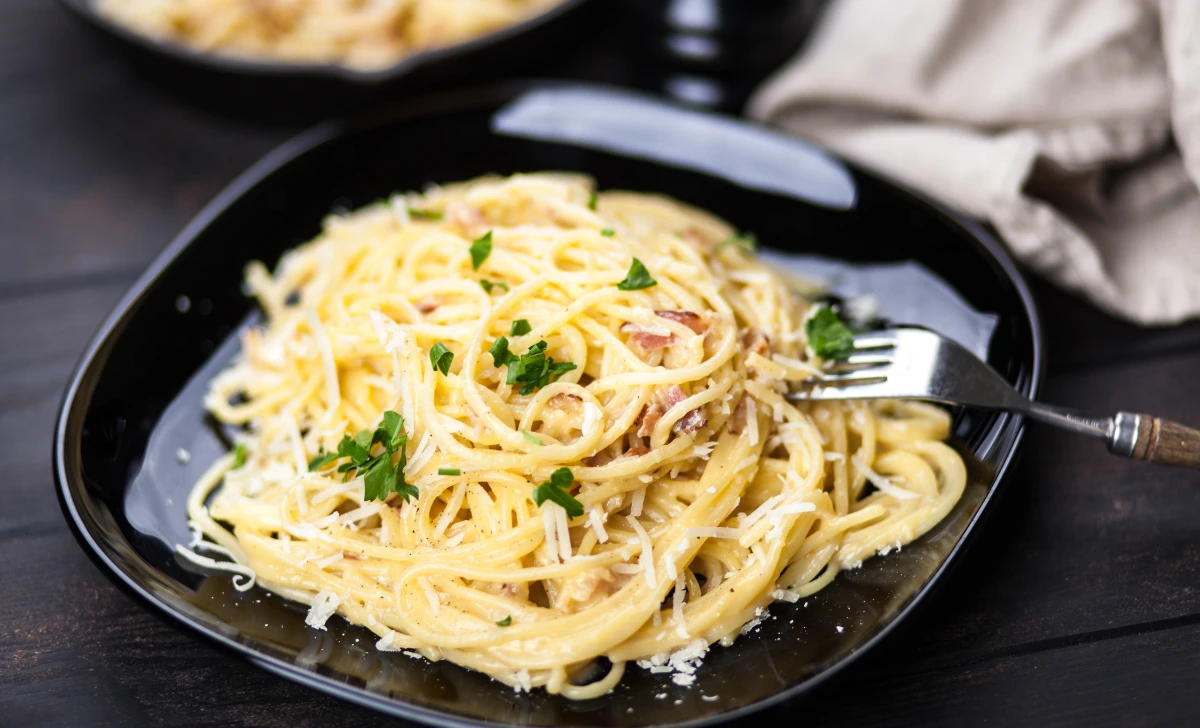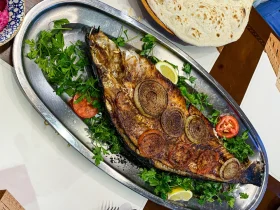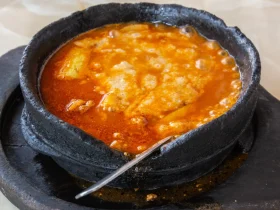Hey there, pasta enthusiasts! Today, we’re diving into the mouthwatering world of Spaghetti Carbonara, a classic Italian dish that’s sure to tantalize your taste buds. Whether you’re a seasoned chef or a kitchen newbie, this recipe will have you serving up a scrumptious plate of creamy goodness in no time. So, let’s put on our aprons and get cooking!
[ez-toc]
History
Before we delve into the cooking process, let’s take a quick trip back in time to uncover the fascinating history behind the beloved Spaghetti Carbonara.
1. Origins and Controversies
The origins of Spaghetti Carbonara are shrouded in mystery, with various tales claiming to be the true birth story of this culinary delight. One popular belief is that the dish was created during World War II, where American soldiers stationed in Italy craved a comforting taste of home. They combined their rations of eggs and bacon with locally available ingredients like Pecorino Romano cheese and black pepper to create the dish we know today.
However, this theory is often disputed, with some arguing that the dish actually predates the war and has its roots in the Apennine Mountains of Italy. It’s said that charcoal workers (carbonai in Italian) would prepare this hearty meal using readily available ingredients while laboring in the woods.
2. Evolution of the Recipe
Regardless of its exact origins, Spaghetti Carbonara evolved over time as different regions and households put their own spin on the dish. The original recipe was rather simple, consisting of only eggs, pancetta or guanciale (cured pork jowl), Pecorino Romano cheese, and black pepper. As the dish gained popularity, cooks started experimenting with additional ingredients like garlic, onions, and cream, deviating from the traditional preparation.
3. The Name Conundrum
The name “Carbonara” itself has sparked debate among culinary historians. Some believe it is derived from the Italian word “carbone,” meaning coal, linking it to the charcoal workers who might have invented the dish. Others argue that the name might refer to the liberal use of black pepper, which gives the dish a speckled appearance resembling coal dust.
4. International Fame
Although Spaghetti Carbonara has ancient Italian origins, its international fame skyrocketed in the mid-20th century. As Italian cuisine gained popularity worldwide, so did this creamy pasta dish. Today, you can find variations of Carbonara on menus across the globe, with each region offering its own unique twist on the classic recipe.
Time
| Step | Time (approx.) |
|---|---|
| Boiling the Spaghetti | 10 minutes |
| Preparing the Pancetta/Guanciale | 5 minutes |
| Whisking the Eggs and Cheese | 3 minutes |
| Combining the Ingredients | 2 minutes |
| Mixing the Sauce and Spaghetti | 3 minutes |
| Resting the Dish | 2 minutes |
| Garnishing with Black Pepper | 1 minute |
| Serving and Enjoying! | – |
The total cooking and preparation time for this Spaghetti Carbonara recipe would be approximately 26 minutes, making it a quick and delicious option for your next meal. Now, let’s continue with the recipe guide, so you can get cooking right away!
Ingredients
| Ingredients | Quantity |
|---|---|
| Spaghetti | 200 grams |
| Eggs | 2 large |
| Pecorino Romano Cheese | 1 cup (grated) |
| Pancetta or Guanciale | 100 grams |
| Freshly Ground Black Pepper | To taste |
| Salt | To taste |
With these ingredients at hand, you’re all set to whip up a delightful Spaghetti Carbonara meal for you and your dining partner. Now let’s move on to the final steps of the recipe!
Directions
Step 1: Boiling the Spaghetti (Time: 10 minutes)
- Fill a large pot with water, allowing enough room for the spaghetti to cook without sticking together.
- Bring the water to a rolling boil over high heat, adding a generous amount of salt for seasoning.
- Gently add the spaghetti to the boiling water, stirring occasionally to prevent clumping.
- Cook the spaghetti until it reaches the desired level of al dente, typically around 8-10 minutes. Check the package instructions for more accurate cooking times.
Step 2: Preparing the Pancetta/Guanciale (Time: 5 minutes)
- While the spaghetti is cooking, take a pan and place it over medium heat.
- Add the sliced pancetta or guanciale to the pan, allowing the fat to render and the meat to become crispy and golden brown.
- Once cooked, remove the pancetta/guanciale from the pan and set it aside on a paper towel to drain any excess grease.
Step 3: Whisking the Eggs and Cheese (Time: 3 minutes)
- In a mixing bowl, crack the eggs and whisk them together until well beaten.
- Grate a generous amount of Pecorino Romano cheese into the bowl with the eggs, reserving some for garnishing later.
- Season the mixture with freshly ground black pepper, adding a pinch of salt if desired.
Step 4: Combining the Ingredients (Time: 2 minutes)
- Once the spaghetti is al dente, drain it well, reserving a small amount of pasta water.
- Immediately add the hot spaghetti to the egg and cheese mixture, tossing quickly to coat the pasta evenly. The residual heat will cook the eggs and create a creamy sauce.
Step 5: Mixing the Sauce and Spaghetti (Time: 3 minutes)
- Return the pancetta/guanciale to the pan and add the coated spaghetti to it.
- Gently toss the ingredients together, ensuring the sauce evenly coats the spaghetti and the pancetta/guanciale is distributed throughout.
Step 6: Resting the Dish (Time: 2 minutes)
- After mixing the ingredients, let the Carbonara rest for a minute or two. This resting period allows the flavors to meld together, resulting in a more harmonious taste.
Step 7: Garnishing with Black Pepper (Time: 1 minute)
- Before serving, add a final touch of freshly ground black pepper over the Carbonara. The aromatic and slightly spicy notes of the pepper will complement the creaminess of the dish.
Step 8: Serving and Enjoying!
- Divide the Spaghetti Carbonara evenly into two serving plates or bowls.
- Garnish each serving with a sprinkle of reserved Pecorino Romano cheese for an extra burst of flavor.
- Pair it with a crisp salad and a glass of your favorite wine for a complete Italian dining experience.
Equipment Required
Nutrition Information
| Nutrition Information (Per Serving) | Amount |
|---|---|
| Serving Size | 1 plate |
| Calories | 750 kcal |
| Total Fat | 40g |
| – Saturated Fat | 15g |
| – Trans Fat | 0g |
| Cholesterol | 280mg |
| Sodium | 1000mg |
| Total Carbohydrates | 65g |
| – Dietary Fiber | 3g |
| – Sugars | 2g |
| Protein | 32g |
Please note that the nutritional values provided are approximate and may vary based on specific ingredients and portion sizes. Enjoy your Spaghetti Carbonara while keeping in mind your dietary preferences and requirements. Bon appétit!
Tips
- Use High-Quality Ingredients: Since this dish relies on a few simple ingredients, make sure to use high-quality eggs, Pecorino Romano cheese, and pancetta or guanciale for the best flavor.
- Cook the Spaghetti Al Dente: Be mindful not to overcook the spaghetti. Cook it al dente, so it retains a slight bite when you bite into it. This texture enhances the overall eating experience.
- Reserve Pasta Water: Before draining the spaghetti, reserve a small cup of pasta water. This starchy water can be used to adjust the sauce’s consistency if needed. Add it gradually while mixing the sauce and spaghetti.
- Toss Quickly and Off the Heat: When combining the hot spaghetti with the egg and cheese mixture, do it quickly off the heat. The residual heat will cook the eggs, creating a luscious, creamy sauce without scrambling them.
- Consider Adding Garlic: While not traditional, some enjoy the addition of minced garlic for extra flavor. If you’re a garlic lover, sauté some minced garlic in the pan before adding the pancetta or guanciale.
- Variation: Mushroom Carbonara: For a vegetarian twist, replace the pancetta or guanciale with sautéed mushrooms. Use a mix of wild mushrooms or portobello for a robust, earthy flavor.
- Variation: Creamy Carbonara: If you prefer a creamier texture, you can add a small amount of heavy cream to the egg and cheese mixture. It will create a luxurious, velvety sauce.
- Avoid Reheating: Spaghetti Carbonara is best enjoyed immediately after preparation. Reheating can cause the sauce to separate, affecting its creamy consistency.
- Serve with Extra Cheese and Pepper: For those who love intense flavors, have additional grated Pecorino Romano cheese and freshly ground black pepper available for sprinkling over the dish at the table.
- Experiment with Spices: Feel free to add a pinch of nutmeg or red pepper flakes for a unique twist to the classic Carbonara.
Pros & Cons
| Pros | Cons |
|---|---|
| ✅ Bursting with Creamy Goodness | ❌ High Calorie Count |
| ✅ Quick and Easy to Prepare | ❌ Not Suitable for Vegetarians |
| ✅ Rich and Indulgent Flavor | ❌ Can Be High in Saturated Fat |
| ✅ Classic Italian Comfort Food | ❌ Not Ideal for Reheating |
| ✅ Customizable with Variations | ❌ May Require Special Ingredients |
Conclusion
In conclusion, Spaghetti Carbonara is an irresistible Italian masterpiece that brings together simplicity and bold flavors in a single plate. With its rich and creamy sauce, complemented by the savory goodness of pancetta or guanciale, this classic dish is sure to leave your taste buds dancing with joy.
Preparing Spaghetti Carbonara is a breeze, making it an excellent choice for a quick and satisfying meal. The combination of eggs, cheese, and pasta results in a comforting and indulgent experience that will transport you straight to the heart of Italy.
While the traditional recipe stands as a timeless favorite, don’t be afraid to get creative and explore various variations to suit your taste preferences. Whether you add mushrooms for a vegetarian twist or a touch of garlic for extra flavor, the possibilities are endless!
So why not don your chef’s hat and apron and embark on a culinary journey with Spaghetti Carbonara? Whether you’re cooking for yourself, a loved one, or hosting a dinner party, this dish is sure to impress and delight. Embrace the rich history and traditions of Italian cuisine as you savor every delectable bite.
So what are you waiting for? Head to the kitchen, gather your ingredients, and dive into the magic of Spaghetti Carbonara. The satisfying aroma and the burst of flavors will make it a dish you’ll want to relish time and time again. Bon appétit! 🍝🍷
Facts
- 🍝 Fact 1: The Roman Origin Debate 🧐
- Legend has it that Spaghetti Carbonara traces its roots back to Rome, where it was initially created by charcoal workers (carbonai) in the Apennine Mountains. These hardworking individuals prepared a hearty meal using easily accessible ingredients like eggs, Pecorino Romano cheese, black pepper, and pancetta or guanciale. However, some culinary historians argue that its true origin lies with American soldiers during World War II, seeking comfort in a taste of home. 🏞️🍳
- 🍝 Fact 2: Pancetta vs. Guanciale – The Pork Showdown! 🐷
- Traditional Carbonara recipes call for either pancetta or guanciale, two types of Italian cured pork. Pancetta, often compared to bacon, comes from the pork belly, while guanciale is made from pork jowl, rendering it richer and more flavorful. Both add unique characteristics to the dish, igniting a never-ending debate among food enthusiasts about which one reigns supreme! 🥓🥚
- 🍝 Fact 3: The Art of Creamy Sauce Creation 🎨
- Creating the velvety sauce for Spaghetti Carbonara requires skillful technique. The mixture of beaten eggs and grated Pecorino Romano cheese transforms into a creamy and dreamy sauce when combined with hot, freshly cooked spaghetti. The secret lies in the residual heat from the pasta, ensuring the eggs cook just enough without turning into scrambled eggs! 🍲🍶
- 🍝 Fact 4: “Carbonara” – A Name Shrouded in Mystery 🕵️♂️
- The name “Carbonara” has led to much speculation among culinary enthusiasts. Some believe it is derived from the Italian word “carbone,” meaning coal, paying homage to the charcoal workers who might have invented the dish. Others argue that the name is inspired by the abundant use of black pepper, resembling specks of coal on the pasta. The mystery remains unsolved! 🔍🍽️
- 🍝 Fact 5: The Role of Pepper in Carbonara 🌶️
- The generous addition of freshly ground black pepper in Carbonara is more than just a flavor enhancer. Italian culinary tradition holds that the pepper represents the “black gold” – the valuable spice traded during ancient times. Adding black pepper to Carbonara is not just for taste; it’s a nod to the rich history and significance of spices in Italy’s culinary heritage. 🇮🇹👨🍳
FAQ’s
Can I use different types of pasta for Spaghetti Carbonara?
While the traditional recipe calls for spaghetti, you can experiment with other pasta shapes like fettuccine or rigatoni. Just ensure they are cooked al dente to maintain the dish’s authentic texture.
Is Spaghetti Carbonara a kid-friendly dish?
Yes, many children enjoy the creamy and flavorful taste of Carbonara. However, be mindful of the high-calorie content, and consider portion sizes for younger kids.
Is there a substitute for Pecorino Romano cheese?
If you can’t find Pecorino Romano, Parmesan cheese works as a suitable alternative. Both cheeses have a similar flavor profile, making Parmesan a viable substitute.
Can I make Spaghetti Carbonara in advance for a dinner party?
It’s best to enjoy Carbonara immediately after preparation to preserve its creamy texture. If you must prepare in advance, store the pasta and sauce separately, then combine just before serving.
Can I use egg yolks only instead of whole eggs?
Yes, you can use egg yolks only for a richer and creamier sauce. However, using whole eggs provides a good balance of flavor and texture.
Is Spaghetti Carbonara gluten-free?
The traditional recipe contains wheat-based pasta, which is not gluten-free. However, you can opt for gluten-free spaghetti to accommodate dietary needs.
Can I add vegetables to Spaghetti Carbonara?
While not traditional, you can add vegetables like peas, asparagus, or spinach for extra color and nutrition. Just blanch them separately before adding to the dish.
What wine pairs best with Spaghetti Carbonara?
A dry white wine like Pinot Grigio or a medium-bodied red like Montepulciano d’Abruzzo complements the dish’s rich flavors.
How can I make Spaghetti Carbonara less calorie-dense?
To reduce calories, use leaner cuts of pancetta or guanciale and opt for whole wheat or low-calorie pasta. Portion control and incorporating more vegetables can also help.
Can I freeze leftover Spaghetti Carbonara for later consumption?
Freezing is not recommended, as the sauce may separate upon thawing. It’s best to enjoy Carbonara fresh to retain its creamy consistency.












Leave a Review